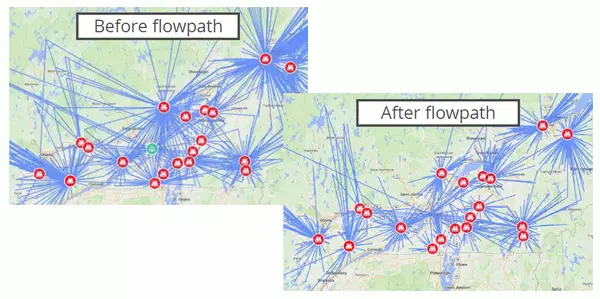


Client's logistics network
Conseil 2.0 is a supply chain consulting firm that helps businesses improve their logistics and operational efficiency through network design, warehouse management, and transportation optimization.
The client is a Canadian agricultural supplier, specializing in seeds and fertilizers, which primarily operates across Canada and the U.S. With a portfolio of 7,000 SKUs, the client owns 19 production facilities and six warehouses and serves around 10,000 customers, including farmers and local businesses.
With a portfolio of 7,000 SKUs, the client faced significant logistical challenges due to the high running costs of the logistics network. The company wanted to assess its supply chain to improve its efficiency and effectiveness.
The challenge included:
To address these challenges, anyLogistix software was used to model and analyze the client's logistics network. The project was divided into several stages:
1. Data Collection and Baseline Supply Chain Modeling and Design: The first step was to gather data on the client’s facilities, customers, and current logistics flows. A baseline model was created to simulate the current network, including transportation routes and warehouse throughput. The baseline provided a foundation to assess inefficiencies and served as a comparison for optimization scenarios.
2. Center of Gravity Analysis: Greenfield or gravity analysis was conducted in anyLogistix to evaluate the optimal warehouse locations. The results showed that the client could reduce the number of warehouses by 50%, with some existing locations being moved by 100 kilometers from the demand centers. This center of gravity analysis suggested potential closures while maintaining service levels within a 100 km radius for 95% of the demand.
3. Transportation Route Optimization: An analysis of the delivery flow paths in anyLogistix identified inefficiencies, such as overlapping truck routes and common service areas. Approximately 30% of the delivery zones were covered by multiple warehouses. By reassigning clients to the closest distribution center, the client could achieve significant savings in transportation costs — 10-30%, depending on scenarios and constraints.

Flow path analysis for transportation route optimization
4. Warehouse Closure Scenarios: Scenarios were created to explore alternatives such as converting the sites into cross-docks or redistributing the inventory flow to other facilities. The analysis showed that closing the "worst-located" warehouses would result in an overall reduction of logistics costs by 15%.
5. Environmental Impact: An important aspect of the project was evaluating the impact of network optimization on carbon emissions. By reducing transportation inefficiencies and optimizing routes, the client could achieve a 30-40% reduction in CO2.
By using anyLogistix's advanced supply chain modeling and design capabilities, Conseil 2.0 advised changes in the logistics network that would deliver substantial improvements in both operational efficiency and environmental sustainability. Key outcomes included:
Warehouse closure scenarios (click to enlarge)
The project provided the client with a roadmap for future improvements and opportunities, including potential network expansions and additional cost-saving strategies. Additionally, it supported their transition toward more sustainable logistics practices.
This case study was presented by Michael Muro, Conseil 2.0, at the anyLogistix Conference 2024.
The slides are available as a PDF.
